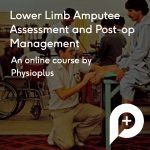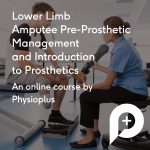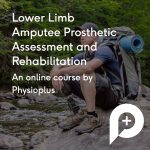This course program was created by the great Physioplus team!
There are many circumstances that can lead to amputations affecting the lower extremities, such as: B. Traumas in traffic accidents and consequences of chronic diseases such as diabetes. With adequate care, access to a prosthesis and the associated rehabilitation, many of these people can regain a high level of functionality and quality of life. The role of the physiotherapist plays a key role. This series of courses offers a comprehensive physiotherapy perspective for working with people with lower limb amputations, which covers working with the client both before and after prescribing prostheses.
It can be difficult to gain experience with amputees, and exposure largely depends on where in the world you work. This brand is difficult when you try to work in this field and get this dream job. We hope that this course program will help you improve your knowledge and start your career in amputee rehab.
Courses part of the program
Introduction to amputee rehabilitation
In order to effectively rehabilitate a person with lower limb amputation, it is important to amputee rehabilitation process and the involvement of the multidisciplinary team in the various phases of the Understand rehabilitation well. Understanding the main causes of the amputation and the principles of the amputation will help you understand how the rehabilitation process can be affected by the condition and the operation.
Introduction to the rehabilitation of amputees
Assessment of lower limb amputees and postoperative management
 In order to effectively rehabilitate a person with lower limb amputation, it is important to have a good understanding of the amputee's rehabilitation process and multidisciplinary team participation have the different phases of rehabilitation. Understanding the main causes of the amputation and the principles of the amputation will help you understand how the rehabilitation process can be affected by the condition causing it and the operation.
In order to effectively rehabilitate a person with lower limb amputation, it is important to have a good understanding of the amputee's rehabilitation process and multidisciplinary team participation have the different phases of rehabilitation. Understanding the main causes of the amputation and the principles of the amputation will help you understand how the rehabilitation process can be affected by the condition causing it and the operation.
Learn more about post-operative management
Pre-prosthetic management of the lower extremities
 Loss of a lower extremity has serious implications for a person's mobility and ability to perform daily activities. This has a negative impact on the participation and integration of a person in society. Prosthetic rehabilitation is a complex task that ideally requires input from an interdisciplinary rehabilitation team. This is the third course in a row and covers all aspects of pre-prosthetic rehabilitation and what therapists should know about prosthetics. You will learn more about outcome measures, pre-adapted physiotherapy management techniques, including bed mobility and transfers, stump / residue management, musculoskeletal considerations, and patient education. They are also introduced to the different types of prostheses, their components, manufacture and assembly.
Loss of a lower extremity has serious implications for a person's mobility and ability to perform daily activities. This has a negative impact on the participation and integration of a person in society. Prosthetic rehabilitation is a complex task that ideally requires input from an interdisciplinary rehabilitation team. This is the third course in a row and covers all aspects of pre-prosthetic rehabilitation and what therapists should know about prosthetics. You will learn more about outcome measures, pre-adapted physiotherapy management techniques, including bed mobility and transfers, stump / residue management, musculoskeletal considerations, and patient education. They are also introduced to the different types of prostheses, their components, manufacture and assembly.
An Introduction to Prosthetics
Prosthetic assessment and rehabilitation of lower limb amputees
 The aim of prosthetic rehabilitation should be to establish an energy-efficient gait, to maintain healthy limbs and to avoid secondary complications. This is the fourth course in a series on rehabilitation of lower limb amputees. In this course you will learn how to approach prosthetic rehabilitation. These include gait evaluation, exercise programs / ideas, gait and balance training, functional activities, advanced gait training skills and high-level rehabilitation. The course will also cover related evidence-based practice guidelines and patient education.
The aim of prosthetic rehabilitation should be to establish an energy-efficient gait, to maintain healthy limbs and to avoid secondary complications. This is the fourth course in a series on rehabilitation of lower limb amputees. In this course you will learn how to approach prosthetic rehabilitation. These include gait evaluation, exercise programs / ideas, gait and balance training, functional activities, advanced gait training skills and high-level rehabilitation. The course will also cover related evidence-based practice guidelines and patient education.
Make your rehab plans as good as possible